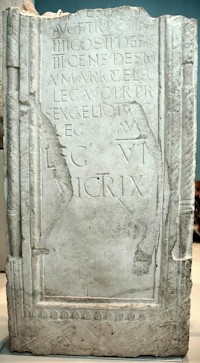Xanten: Victory Monument
Q2535566Xanten victory monument: inscription commemorating the end of the Batavian Revolt, found at Vynen, north of Xanten.

The text of this monument, which was found near Vynen (north of Xanten) and can be seen in the Rheinisches Landesmuseum in Bonn, illustrates the suppression of the Batavian Revolt in the summer of 70.
IMPeratoris VESPASIANI
AVGvsti Filio TRibvnicia POTestate IMPeratore
IIII COnSvle II DESIGnato
III CENSoribvs DESIGnatis
Avlo MARIO CELSO
LEGato AVGvsti PRo PRaetore
SEXto CAELIO TVSCO
LEGato AVGvsti
LEGio VI
VICTRIX... to the son2 of imperator Vespasian
Augustus, with tribunician
powers, imperator for the
fourth time, twice consul, appointed
for a third term, appointed as censors,
to Aulus Marius Celsus,
governor with the rank of propraetor,
and to Sextus Caelius Tuscus,
commander, [this was monument dedicated by]
the Sixth legion
Victrix (more...)
In the confusion after the suicide of the emperor Nero in June 69, the commander of the army of Germania Inferior, Aulus Vitellius, had used the Rhine army to march on Rome. His campaign had been successful, and judging from what measures are known (like appointing Roman knights as heads of the bureaucracy), he might have been a great ruler. However, once Vitellius had become emperor, the eastern legions revolted, proclaiming their commander Vespasian emperor (July 69). The army of the Lower Danube sided with the new pretender, and in December, the forces of Vespasian had captured Rome.
During the civil war, the Rhine frontier was poorly protected and the Batavians, a tribe living in the Lower Rhine area, revolted. Led by Julius Civilis, they besieged and captured the Roman base at Xanten, and the revolt spread to the valleys of the Moselle and Meuse. In 70, Vespasian sent an army to the north to restore order; it was commanded by Quintus Petillius Cerialis, who had already taken part in the march on Rome, and was to have an important command in Britain. After an advance to Mainz and Trier, the expeditionary force moved to the north, to Cologne, which had liberated itself, and to Xanten.
Here, the Batavians tried to defend their homeland. After a fight of two days, the Roman legion II Adiutrix, VI Victrix, XIV Gemina, and XXI Rapax overcame their adversaries. The legionaries of the Sixth dedicated their victory to the emperor, his son Titus, governor Aulus Marius Celsus, and their commander Sextus Caelius Tuscus. This inscription is the lower part of the victory monument; the upper part, in which the emperor himself must have been mentioned (note the plural censors in the fourth line). It is remarkable that Cerialis is absent.